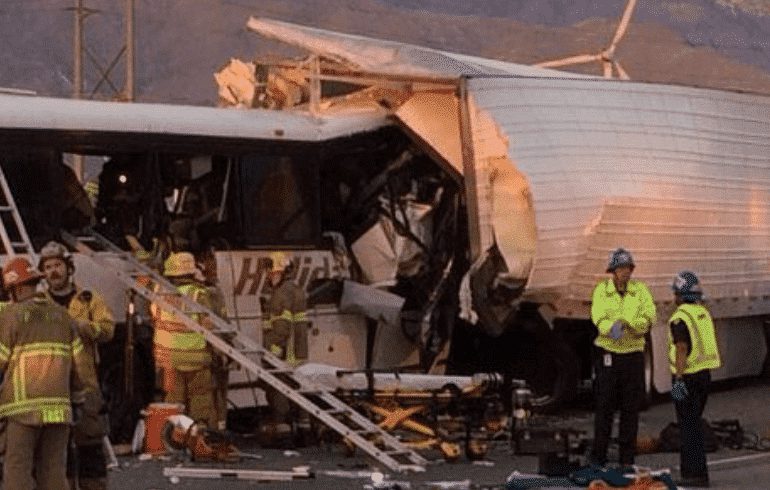The National Transportation Safety Board (NTSB) held a meeting on Tuesday to discuss the probable cause of the fatal Palm Springs crash on Interstate 10 that happened last year.
Details of the Accident
The crash happened on October 23, 2016, around 5 a.m. on westbound I-10 near Desert Hot Springs. Traffic in the area had slowed for a maintenance crew.
According to the California Highway Patrol, the USA Holiday tour bus was traveling “significantly faster” than the semi when it crashed, demolishing the front of the bus and shredding the trailer of the semi. CHP stated, “The speed of the bus was so significant that the trailer itself entered about 15 feet into the bus … You can see it was a substantial impact.”
Tragic couple of weeks in Palm Springs. Horrific, actually. https://t.co/VZLEti67Co
— Andrew John (@Andrew_L_John) October 24, 2016
Of the 44 people on the tour bus, thirteen were killed, including the bus driver. Another 31 people were injured. Many of the injured suffered facial trauma as they were not restrained in the bus. The truck driver also suffered minor injuries in the crash.
The trucker who was hit by the bus described the horrific experience: “The impact just, you know, hit me from behind and I just blacked out for a minute and when I gained my consciousness, I undid my seatbelt and looked around. Thought I got ran over by something. That’s when I got out of my truck.”
The NTSB released this diagram showing the positions of each victim of last year’s fatal bus collision @MyDesert pic.twitter.com/3kLt7vxMcQ
— Colin Atagi (@TDSColinAtagi) October 31, 2017
Determined Probable Causes
Since the crash, the NTSB investigators have not made any public statements about the incident or updated the public about the ongoing investigation, according to KESQ.
Now, the NTSB attribute this crash to three different probable causes:
- One, the California Department of Transportation inadequate management for the traffic break which resulted in a hazardous traffic situation which law enforcement did not detect the lack of movement after the traffic break ended and the bus driver did not receive advanced warning of potential traffic ahead.
- The truck driver not moving likely due to his falling asleep because of his undiagnosed severe — sleep apnea.
- And the bus driver’s failure to avoid the crash as a result of fatigue and the fact he did not expect to encounter stopped traffic.
Subsequently, the Riverside County District Attorney’s Office has charged the truck driver, Bruce Guilford, 51, of Covington, Georgia, with vehicular manslaughter and reckless driving.
Guilford was arrested in his home 2 weeks ago and is awaiting extradition to California to face more than 40 felony and misdemeanor counts.
NTSB: Tour bus driver should have seen stopped truck https://t.co/MyqHmtWiIj
— Coachella Vl News (@CoachellaVlNews) October 31, 2017
There has been no date set for Guilford’s arraignment. His bail is set at $500,000 – an amount his attorney is arguing to reduce. Further, his attorney is working to recall the arrest warrant entirely.
He is currently being held at the Newton County jail in Georgia.
Too many driving hours and serious consequences
California Highway Patrol (CHP) investigators allege that Guilford was well over his driving hours of service. He not only suffers from sleep apnea but was seriously sleep deprived on the morning of the crash, according to investigators.
CHP is suggesting that if Guilford had been well rested, he would not have stopped his rig on the highway putting himself and others on the road (the tour bus) at risk for a collision.
In an arrest warrant declaration, Guilford was alleged to be on the second of two consecutive round trips from Alabama to California when the crash occurred. He also was alleged to have falsified his driver logs to hide the number of hours he’d spent on the road.
The party found to be at most fault, however, was the tour bus driver. CHP Officer Scott Parent said Guilford was “not the party determined to be most at fault for this collision,” though falling asleep behind the wheel “was a substantial factor in the deaths of 13 individuals.”
Tour bus driver was most at fault for Palm Springs freeway crash that killed 13, CHP says https://t.co/qYUgIPKLze pic.twitter.com/P1QX9uf39C
— Pasadena Star News (@PasStarNews) October 26, 2017
The truck should not have been stopped, but the tour bus driver also could have taken evasive action to avoid colliding with the truck, according to findings from the NTSB.
Reports also indicate that the tour bus driver was fighting fatigue the morning of the accident.
The Desert Sun reported that the tour bus driver, Teodulo Elias Vides, got only 4 hours of sleep the night of October 21, 2016, when the tour bus departed for the Red Earth Casino on the 22nd. Then before heading back from the casino on October 23, 2016, Vides only slept 1 hour just before he hit the road home.
Tour bus driver who crashed last year, killing 13, slept only four hours in the 35 hours before the crash. https://t.co/mPm2iYL3e5
— Brett Kelman (@TDSbrettkelman) October 31, 2017
The collision occurred even though Vides had about 20 seconds to see the big rig before impact, officials said, adding that other vehicles managed to avoid the truck.
Further, NTSB investigators concluded through their initial on-scene investigation that six of the eight bus tires were overly worn and out of compliance with federal regulations, but the report does not identify the tires as a contributing factor to the crash.
Since the accident, at least 10 lawsuits have been filed by surviving victims or family members involved in this accident. These cases are in the process of being consolidated.
“We’re tired, yes we are tired, of seeing commercial drivers being tired,” NTSB chairman Robert Sumwalt said during the hearing.
